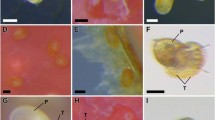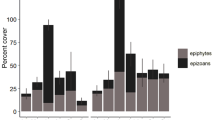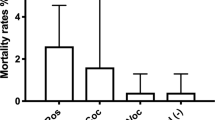Abstract
Settlement sites of marine invertebrate larvae are frequently influenced by positive or negative cues, many of which are chemical in nature. Following from the observation that many shallow-water, Hawai'ian marine macroalgae are free of fouling by sessile invertebrates, we predicted that the algae are chemically protected and dependent on either surface-bound or continuously released soluble compounds to deter settling invertebrate larvae. To address the importance of waterborne algal compounds, we experimentally determined whether larvae of two of Hawai'i's dominant hard-surface fouling organisms, the polychaete tube worm Hydroides elegans and the bryozoan Bugula neritina, would settle in the presence of waters conditioned by 12 species of common Hawai'ian macroalgae (representing the Phaeophyta, Chlorophyta, Rhodophyta and Cyanophyta). The results included a full spectrum of biological responses by each larval species to waterborne algal compounds. Larval responses to conditioned water were consistent for each algal species, but the outcomes were not predictable based on the taxonomic relationships of the algae. For example, among the species of Phaeophyta examined, different conditioned waters were: (1) toxic, (2) inhibited settlement, (3) simulated settlement, or (4) had no effect, compared to larvae in control dishes containing filtered seawater. Additionally, larval responses to aged (24 h) conditioned waters could not be predicted from the results of assays run with conditioned waters utilized immediately after preparation. Finally, settlement by larvae of one species did not predict outcomes of tests for the other species. Four of 12 shallow-reef Hawai'ian macroalgae tested released compounds into surrounding waters that immediately killed or inhibited settlement by both H. elegans and B. neritina (toxic: Dictyota sandvicensis; inhibitory: Halimeda discoidea, Sphacelaria tribuloides, Ulva reticulata); the remaining 8 algal species prevented settlement by one of these fouling organisms but for the other had no effect or, in some cases, even stimulated settlement
Similar content being viewed by others
References
Almodovar LR (1964) Ecological aspects of some antibiotic algae in Puerto Rico. Botanica mar 6: 143–146
Al-Ogily SM, Knight-Jones EW (1977) Anti-fouling role of antibiotics produced by marine algae and bryozoans. Nature, Lond 265: 728–729
Bahamondes-Rojas I, Dherbomez M (1990) Purification partielle des substances glycoconjugees capables d'induire la metamorphose des larves competentes d'Eubranchus doriae (Trinchese, 1879) mollusque nudibranche. J exp mar Biol Ecol 144: 17–27
Beach K, Smith CM, Michael T, Shin HW (1995) Photosynthesis in repoductive unicells of Ulva fasciata and Enteromorpha flexuosa: implications for ecological success. Mar Ecol Prog Ser 125: 229–237
Bernstein BB, Jung N (1979) Selective pressures and coevolution in a kelp canopy community in Southern California. Ecol Monogr 49: 335–355
Caccamese S, Azzolina R, Furnari G, Cormaci M, Grasso S (1980) Antimicrobial and antiviral activities of extracts from Mediterranean algae. Botanica mar 23: 285–288
Crisp DJ (1967) Chemical factors inducing settlement in Crassostrea virginica (Gmelin). J Anim Ecol 36: 329–335
Crisp DJ (1974) Factors inflencing the settlement of marine invertebrate larvae. In: Grant PT, Mackie AT (eds) Chemoreception in marine organisms. Academic Press, New York, pp 177–265
Crisp DJ (1976) Settlement responses in marine organisms. In: Newell RC (ed) Adaptation to environments: essays on the physiology of marine animals. Butterworths, London, pp 83–124
Crisp DJ (1984) Overview of research on marine invertebrate larvae, 1940–1980. In: Costlow JD, Tipper RC (eds) Marine biodeterioration: an interdisciplinary study. Naval Institute Press, Annapolis, Md, pp 103–126
Crisp DJ, Meadows PS (1962) The chemical basis of gregariousness in cirripedes. Proc R Soc (Ser B) 156: 500–520
Crisp DJ, Meadows PS (1963) Adsorbed layers: the stimulus for settlement in barnacles. Proc R Soc (Ser B) 158: 364–387
Crisp DJ, Williams GB (1960) Effect of extracts from fucoids in promoting settlement of epiphytic Polyzoa. Nature, Lond 188: 1206–1207
Davis AR, Targett NM, McConnell OJ, Young CM (1989) Epibiosis of marine algae and benthic invertebrates: natural products chemistry and other mechanisms inhibiting settlement and overgrowth. In: Scheuer PJ (ed) Bioorganic marine chemistry. Vol. 3. Springer-Verlag, Berlin, pp 85–114
Davis AR, Wright AE (1990) Inhibition of larval settlement by natural products from the ascidian, Eudistoma olivaceum (Van Name). J chem Ecol 16: 1349–1357
Dawson EY (1966) Marine botany, Holt, Rinehart & Winston, Inc. New York
De Nys R Steinberg PD, Willemsen P, Dworjanyn SA, Gabelish CL, King RJ (1995) Broad spectrum effects of secondary metabolites from the red alga Delisea pulchra in antifouling assays. Biofouling 8: 259–271
Dixon J, Schroeter SC, Kastendiek J (1981) Effects of the encrusting bryozoan Membranipora membranacea on the loss of blades and fronds by the giant kelp Macrocystis pyrifera (Laminariales). J Phycol 17: 341–345
Faulkner DJ (1984) Marine natural products: metabolites of marine algae and herbivorous marine molluscs. Nat Product Rep 1: 251–280
Grosberg RK (1981) Competitive ability influences havitat choice in marine invertebrates. Nature, Lond 290: 700–702
Gschwend PM, MacFarlane JK, Newman KA (1985) Volatile halogenated organic compunds released to seawater from temperate marine macroalgae. Science, NY 227: 1033–1035
Hadfield MG (1977) Chemical interactions in larval settling of a marine gastroped. In: Faulkner DJ, Fenical WH (eds) Marine natural products chemistry. Plenum Press, New York, pp 403–413
Hadfield MG (1978) Metamorphosis in marine molluscan larvae: an analysis of stimulus and response. In: Chia FS, Rice ME (eds) Settlement and metamorphosis of marine invertebrate larvae. Elsevier, New York, pp 165–175
Hadfield MG, Scheuer D (1985) Evidence for a soluble metamorphic inducer in Phestilla: ecological, chemical and biological data. Bull mar Sci 37: 556–566
Hadfield MG, Unabia CC, Smith CM, Michael TM (1994) Settlement preferences of the ubiquitous fouler Hydroides elegans. In: Thompson MF, Nagabhushanam R, Sarojini R, Fingerman M (eds) Recent developments in biofouling control. Oxford and IBH Publishing Co. New Delhi, pp 67–74
Hay ME, Fenical W (1988) Marine plant-herbivore interactions: the ecology of chemical defense. A Rev Ecol Syst 19: 111–145
Highsmith RC (1982) Induced settlement and metamorphosis of sand dollar (Dendraster excentricus) larvae in predator-free sites: adult sand dollar beds. Ecology 63: 329–337
Hodgson LM (1984) Antimicrobial and antineoplastic activity in some south Florida seaweeds. Botanica mar 27: 387–390
Holmström C, Kjelleberg S (1994) The effect of external biological factors on settlement of marine invertebrate and new antifouling technology. Biofouling 8: 147–160
Holmström C, Rittschof D, Kjelleberg S (1992) Inhibition of settlement by larvae of Balamus amphitrite and Ciona intestinalis by a surface-colonizing marine bacterium. Appl envirl Microbiol 58: 2111–2115
Jensen R, Morse DE (1990) Chemically induced metamorphosis of polychaete larvae in both the laboratory and ocean environment. J Chem Ecol 16: 911–930
Johnson CR, Muir DG, Reysenbach AL (1991a) Characteristic bacteria associated with surfaces of coralline algae: a hypothesis for bacterial induction of marine invertebrate larvae. Mar Ecol Prog Ser 74: 281–294
Johnson CR, Sutton DC, Olson RR, Giddens R (1991b) Settlement of crown-of-thorns starfish: role of bacteria on surfaces of coralline algae and a hypothesis for deep water recruitment. Mar Ecol Prog Ser 71: 143–162
Johnson LE, Strathmann RR (1989) Settling barnacle larvae avoid substrata previously occupied by a mobile predator. J exp mar Biol Ecol 128: 87–103
Keough MJ, Raimondi PT (1995) Responses of settling invertebrate larvae to bioorganic films: effects of different types of films. J exp mar Biol Ecol 185: 235–253
Kirchman D, Graham S, Reish D, Mitchell R (1982) Bacteria induce settlement and metamorphosis of Janua (Dexiospira) brasiliensis Grube (Polychaeta: Spirobidae). J exp mar Biol Ecol 56: 153–163
Knight-Jones EW, Crisp DJ (1953) Gregariousness in barnacles in relation to the fouling of ships and to anti-fouling research. Nature, Lond 171: p. 1109
Lee RE (1989) Phycology. Cambridge University Press, Cambridge, England
Littler DS, Littler MM, Bucher KE, Norris JN (1989) Marine plants of the Caribbean. A field guide from Florida to Brazil. Smithsonian Institution Press, Washington, DC
Littler MM, Littler DS, Taylor PR (1987) Animal-plant defense associations: effects on the distribution and abundance of tropical reef macrophytes. J exp mar Biol Ecol 105: 107–121
Lynch WF (1947) The behavior and metamorphosis of the larvae of Bugula neritina (Linnaeus): experimental modification of the length of the free-swimming period and the responses to light and gravity. Biol Bull mar biol Lab, Woods Hole 92: 115–150
Magruder WH, Hunt JW (1979) Seaweeds of Hawaii. The Oriental Publishing Co. Honolulu, Hawaii
Maki JS, Rittschol D, Costlow JD, Mitchell R (1988) Inhibition of attachment of larval barnacles, Balanus amphitrite, by bacterial films. Mar Biol 97: 199–206
Maki JS, Rittschof D, Schmidt AR, Snyder AG, Mitchell R (1989) Factors controlling attachment of bryozoan larvae: a comparison of bacterial films and unfilmed surfaces. Biol Bull mar biol Lab, Woods Hole 177: 295–302
McGee BL, Targett NM (1989) Larval habitat selection in Crepidula (L.) and its effect on adult distribution patterns. J exp mar Biol Ecol 131: 195–214
McLachlan J, Craige JS (1966) Antialgal activity of some simple phenols. J Phycol 2: 133–135
Mihm JW, Banata WC, Loeb GI (1981) Effects of absorbed organic and primary fouling films on bryozoan settlement. J exp mar Biol Ecol 54: 167–179
Mitchell R, Kirchman D (1984) The microbial ecology of marine surfaces. In: Costlow JD, Tipper RC (eds) Marine biodeterioration: an interdisciplinary study. Naval Institute Press, Annapolis, pp 49–56
Morse ANC, Morse DE (1984) Recruitment and metamorphosis of Haliotis larvae induced by molecules uniquely available at the surfaces of crustose red algae. J exp mar Biol Ecol 75:191–215
Morse DE, Tegner M, Duncan H, Hooker N, Trevelyan G, Cameron A (1980) Induction of settling and metamorphosis of planktonic molluscan (Haliotis) larvae. III. Signaling by metabolites of intact algae is dependem on contact. In: Muller-Schwarze D, Silverstein RM (eds) Chemical signals. Plenum Press, New York, pp 67–86
Oswald RC, Telford N, Seed R, Happy-Wood CM (1984) The effect of encrusting bryozoans on the photosynthetic activity of Fucus serratus L. Estuar, estl Shelf Sci 19: 697–702
Paul VJ (1992) Seawood chemical defenses on coral reefs. In: Paul VJ (ed) Ecological roles of marine natural products. Comstock Publishing Associates. Ithaca, NY, pp 24–50
Paul VJ, Hay ME (1986) Seaweed susceptibility to herbivory: chemical and morphological correlates. Mar Ecol Prog Ser 33: 255–264
Paul VJ, Van Alstyne KL (1988) Chemical defense and chemical variation in some tropical Pacific species of Halimeda (Halimedaccae: Chlorophyta). Coral Reefs 6: 263–269
Pawlik JR (1992) Chemical ecology of the settlment of benthic marine invertebrates. Oceanogr mar Biol A Rev 30: 273–335
Pechenik JA, Cerulli TR (1991) Influence of delayed metamorphosis on survival, growth, and reproduction of the marine polychaete Capitella sp. I. J exp mar Biol Ecol 51: 17–27
Pennington JT, Hadfield MG (1989) Larvae of a nudibranch mollusc (Phestilla sibogae) metamorphose when exposed to common organic solvents. Biol Bull mar biol Lab Woods Hole 177: 350–355
Renaud P, Hay ME, Schmitt TM (1990) Interactions of plant stress and herbivory: intraspecific variation in the susceptibility of a palatable versus and unpalatable seaweed to sea urchin grazing. Oecologia 82: 217–226
Rice ME (1986) Factors influencing larval metamorphosis in Golfingia misakiana (Sipuncula) Bull mar Sci 39: 362–375
Rittschof D, Hooper IR, Costlow JD (1988) Settlement inhibition of marine invertebrate larvae: comparison of sensitivities of bryozoan and barnacle larvae. In: Thompson MF, Sarojini R, Nagabhushanam R (eds) Marine biodeterioration. Oxford and IBH Publishing Co. New Delhi, pp 509–608
Roberts D, Rittschof D, Holm E, Schmidt AR (1991) Factors influencing initial larval settlement: temporal, spatial and surface molecular components. J exp mar Biol Ecol 150: 203–222
SAS Institute, Inc. (1988) SAS user's guide: statistics. 6.03 edn. SAS Institute, Inc. Cary, North Carolina
Scheltema RS (1961) Metamorphosis of the veliger larvae of Nassarius obsoletus (Gastropoda) in response to bottom sediment. Biol Bull mar biol Lab, Woods Hole 120: 92–109
Scheltema RS (1974) Biological interactions determining larval settlement of marine invertebrates. Thalassia jugosl 10: 263–296
Schmitt TM, Hay ME, Lindquist N (1995) Constraints on chemically mediated coevolution: multiple functions for seaweed secondary metabolites. Ecology 76: 107–123
Sieburth JM, Conover JT (1965) Sargassum tannin, an antibiotic which retards fouling. Nature, Lond 208: 52–53
Szewzyk U, Holmström C, Wrangstadh M, Samuelson MO, Maki JS, Kjelleberg S (1991) Relevance of the exopolysaccharide of marine Pseudomonas sp. strain S9 for the attachment of Ciona larvae. Mar Ecol Prog Ser 75: 259–265
Tamburri MN, Zimmer-Faust RK, Tamplin ML (1992) Natural sources and properties of chemcial inducers mediating settlement of oyster larvae: a re-examination. Biol Bull mar biol Lab, Woods Hole 183: 327–338
Todd JS, Zimmerman RC, Crews P, Alberte RS (1993) The antifouling activity of natural and synthetic phenolic acid sulfate esters. Phytochem 34: 401–404
Williams GB (1964) The effect of extracts of Fucus serratus in promoting the settlement of larvae of Spirorbis borealis (Polychaeta). J mar biol Ass UK 44: 397–414
Woodin SA (1991) Recruitment of infauna: positive or negative cues? Am Zool 31: 797–807
Woodin SA, Marinelli RL (1991) Biogenic habitat modification in marine sediments: the importance of speicies composition and activity. In: Meadows PS, Tufail A (eds) The environmental impact of burrowing animals and animal burrows. Zoological Society, London, pp 231–250 (Symp zool Soc Lond No. 63)
Woodin SA, Marinelli RL, Lincoln DE (1993) Allelochemical inhibition of recruitment in a sedimentary assemblage. J chem Ecol 19: 517–530
Woollacott RM (1984) Environmental factors in bryozoan settlement. In: Costlow JD, Tipper RC (eds) Marine biodeterioration: an interdisciplinary study. Naval Institute Press, Annapolis, pp 149–154
Woollacott RM, North WJ (1971) Bryozoans of California and North Mexico kelp beds. Beih Nova Hedwigia 32: 455–479
Young CM, Chia FS (1981) Laboratory evidence for delay of larval settlment in response to a dominant competitor. Int J Invert Reprod 3: 221–226
ZoBell CE, Allen EC (1935) The significance of marine bacteria in the fouling of submerged surfaces. J Bact 29: 239–251
Author information
Authors and Affiliations
Additional information
Communicated by M. F. Strathmann, Friday Harbor
Rights and permissions
About this article
Cite this article
Walters, L.J., Hadfield, M.G. & Smith, C.M. Waterborne chemical compounds in tropical macroalgae: positive and negative cues for larval settlement. Marine Biology 126, 383–393 (1996). https://doi.org/10.1007/BF00354620
Received:
Accepted:
Issue Date:
DOI: https://doi.org/10.1007/BF00354620




